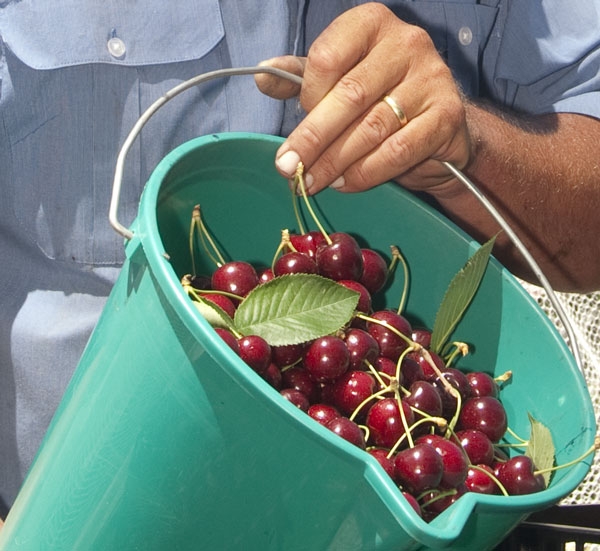Growing big cherries, 28 mm (10 g) and larger, depends on how many cells there are in each cherry and how large those cells will be at harvest.
There are millions of cells in a cherry. How large these cells will get at harvest is not only genetically regulated, it can also be influenced by crop load.
Cells in a cherry are referred to as the mesocarp, or fruit flesh that we eat.
About half of the cells in a ripe cherry are already present at the time of flowering, because cell division of the ovary wall occurs about ten days before a flower is fully open.
The rest of the cells are formed within the first two weeks of fruit growth. After the stone has hardened, the cells will expand by taking up water and sugar until the cherry is mature.
Cells are not all uniform in size. Some are big and round and some are small. A greater proportion of large cells, not more cells, give large cherries at harvest.
A moderate to light crop load tends to have a greater number of large cells, which lead to larger cherries at harvest than a heavy crop load.
Manipulate crop load for larger cherries
In the past, large trees prevented any manipulations in crop load that may have improved fruit size.
Over-setting may have occasionally been a problem, but heavy pruning reduced fruit load adequately to produce cherries of marketable size.
However, with high density planting, modern tree training systems, and self-fertile varieties, methods to reduce crop load has become more important.
Thinning spurs
One method to reduce crop load is to thin spurs in winter.
Thinning spurs is easily and quickly done by running your secateurs along the top and/or bottom of a branch. The number of spurs you remove depends on the initial number present, and tree vigour.
In fact, if you do a good job, the branches that you spur-thinned can continue to produce large fruit in the second year, without further spur thinning.
Nutrient reserves affect fruit size
When a cherry tree flowers it has no leaves yet, and is therefore totally dependent on its reserves of nutrients and carbohydrates.
After flowering, fruit, leaves and shoots all develop at the same time, and compete for these reserves. Most of the reserves are stored in the roots.
The amount of reserves present in the tree affects the early stages of fruit development, which in turn determines final fruit size and yield.
Such effects are in addition—and perhaps as important as photosynthesis is—to that of fruit growth following hardening of the stone.
Thinning spurs allows the remaining spurs to share in a larger proportion of these reserves than when spurs are not thinned.
Spur leaves
Spur leaves develop quickly and produce the photosynthates that are necessary for further fruit development when most of the reserves are used up in early spring.
A strong correlation exists between the total leaf area of a spur and the size, colour and sugar content of the cherries on the same spur.
Benefits of crop regulation
Regulating the crop load through spur thinning allows the flowers to draw more on the tree’s reserves of nutrients and carbohydrates; it produces a large leaf area per spur to benefit fruit growth after stone hardening; and it leads to more large cells and big cherries at time of harvest.
See all the photos in the November 2012 Tree Fruit






















